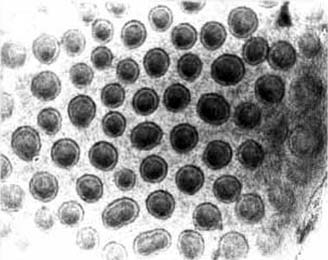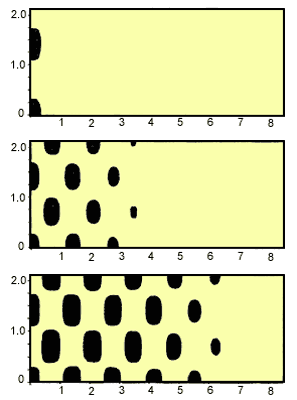 |
The mechanochemical theory of morphogenesis
One of the central issues in developmental biology concerns the formation of spatial pattern. In 1952, Alan Turing (Phil. Trans. Roy. Soc. Lond. B 237, 37-72, 1952) proposed a theory for pattern formation in which he showed that a system of chemicals could evolve spontaneously into a spatial pattern (the first example of self-organisation) and he hypothesized that this served as a pre-pattern for subsequent cell differentiation. In 1983, Oster, Murray and Harris (J. Embryol.Exp.Morph, 78, 83-125, 1983) proposed an alternative theory for morphogenesis, in which mechanical effects induced cell motion and cells formed clumps which then differentiated. The resulting system of equations describing the evolution of cell density, extracellular matrix (ECM) displacement and density is a highly complex system of coupled nonlinear partial differential equations of different types.
In publication 6 we numerically solve the model in one spatial dimension to show that it can give rise to self-organised patterns and in publication 11 we compare and contrast this theory with that of Turing. We extend the modelling approach to account for tissue-tissue interaction, which appears to be very important in the formation of skin organs, in particular in the generation of the regular pattern of feather primordia observed on the dorsal surface of the chick. In a series of papers (publications 30, 34, 47, 48, 79, 106) we show, using a mixture of nonlinear bifurcation analysis, novel travelling wave analysis, and numerical simulation, that this model can exhibit self-organised patterns in one- and two-spatial dimensions, such as rolls, hexagons and squares, as well as travelling wave profiles which leave, in their wake, complex stationary spatial patterns. We show further that the model is consistent with the spatiotemporal generation of chick feather primordia and can explain the results of certain classical experimental manipulations of the system. Moreover, the model makes predictions on how the spatial wavelength of the pattern could be changed by varying experimental parameters.
 |
Dissociated dermal mesenchymal cells can simultaneously organise into spatial patterns. 2 days after being reconstituted with an intact epidermis, morphologically normal feather buds of similar size to the control formed and were arranged in hexagonal patterns similar to that of intact skin (Jiang et al, Development, 126, 4997-5009, 1999 - ) [Reproduced with permission]
 |
 |
Staining showing the sequential formation of feather bud primordia propagation outwards from the dorsal midline to form an hexagonal spatial pattern (Widelitz et al, Development, 126, 2577-2587, 1992) [Reproduced with permission]
 |
Sequential spatial pattern formation in a tissue interaction model. Regions of high cell density are shaded in black. (A) Initially a single row is specified at one end of a regular domain (corresponding to the chick dorsal midline). As the model system evolves, the pattern propagates along the domain with rows added sequentially (B) and (C). [Reproduced with permission from publication 34]
** Work carried out in collaboration with J.D. Murray, G.C. Cruywagen, G.F. Oster, A.S. Perelson and J.M. Hyman